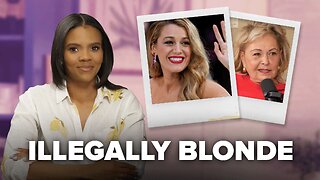Premium Only Content

Sometimes cats are feeling very lazy.
The British Shorthair is a relatively powerful-looking large cat, having a broad chest, strong thick-set legs with rounded paws and a medium-length, blunt-tipped tail. The head is relatively large and rounded, with a short muzzle, broad cheeks (most noticeable in mature males, who tend to develop prominent jowls) and large round eyes that are deep coppery orange in the British Blue and otherwise vary in colour depending on the coat. Their large ears are broad and widely set.[10]
The British Blue variant can often be confused with the grey Scottish Fold, a breed closely related to the British Shorthair. However, the Shorthair can be characterised by having its pointy triangle ears, whereas the Fold has softer, folded ears.
They are slow to mature in comparison with most cat breeds, reaching full physical development at approximately three years of age. Unusually among domestic cats they are a noticeably sexually dimorphic breed, with males averaging 9–17 lb (4.1–7.7 kg) and females 7–12 lb (3.2–5.4 kg).
Coat, colour, and patterns
Edit
The British Shorthair's coat is one of the breed's defining features. It is very dense but does not have an undercoat; thus, the texture is plush rather than woolly or fluffy, with a firm, "crisp" pile that breaks noticeably over the cat's body as it moves.[4][10]
Although the British Blue remains the most familiar variant, British Shorthairs have been developed in many other colours and patterns. Black, blue, white, red, cream, silver, golden and—most recently—cinnamon and fawn are accepted by all official standards, either solid or in colourpoint, tabby, shaded and bicolour patterns; the GCCF, FIFe and TICA also accept chocolate and its dilute lilac, disallowed in the CFA standard.[13] All colours and patterns also have tortoiseshell variants.[10]
The Tabby patterns include:[14] Classic Tabby, Mackerel Tabby, Spotted & Ticked Tabby. The non-tabby patterns include: Tortoiseshell, Bi-Colour, Van patterns Bi-Colour & White, Smoke, Tipped & Colourpointed.
British Shorthair's nose color: black, cherry red, brick red; a circle of black nasal line on the periphery.
4-month-old golden shaded male kitten
5-month-old lilac female kitten
Blue bicolour adult male
6-month-old silver classic tabby male kitten
British shorthair in silver coat octa
Temperament
Edit
A young female cat showing that British Shorthairs prefer to stay near people rather than squatting on laps
They are an easygoing and dignified breed, not as active and playful as many, but sweet-natured and devoted to their owners, making them a favorite of animal trainers. They tend to be safe around other pets and children since they will tolerate a fair amount of physical interaction, but as a rule do not like to be picked up or carried. They require only minimal grooming and take well to being kept as indoor-only cats; however, they can be prone to obesity unless care is taken with their diet.[4][11] They are quiet and vigilant, but if they trust their owners, they will silently follow the owners’ activities and stay with them. British Shorthair cats are not lap cats. They are more accustomed to staying beside people than squatting on people’s laps. Similarly, they prefer the feeling of having their feet on the ground. They have low voice and a moderate activity level. When there is no one at home, they will stay at home quietly and wait for their owners to come back.
-
 LIVE
LIVE
2 MIKES LIVE
2 hours ago2 MIKES LIVE #208 Deep Dive Monday!
239 watching -
 29:31
29:31
Kimberly Guilfoyle
4 hours agoThe Great American Comeback, Live with Nick Adams | Ep215
57.8K15 -
 1:30:43
1:30:43
Redacted News
4 hours agoGlobalist Cabal Suffers MAJOR losses as WEF's Klaus Schawb out, WEF Pope Francis dies, and WHO caves
120K133 -
 57:25
57:25
Candace Show Podcast
4 hours agoBlake Lively Filed A Sham Lawsuit. Is This Now A Criminal Case? | Candace Ep 179
86.6K104 -
 1:14:38
1:14:38
The HotSeat
4 hours agoGut the DOD, Gut the Country—And That’s Exactly the Plan
35.1K10 -
 11:10:06
11:10:06
LFA TV
22 hours agoALL DAY LIVE STREAM 4/21/25
133K16 -
 2:12:21
2:12:21
The Quartering
7 hours agoKarmelo Anthony PSYOP, Joe Rogan Attack, Pete Hegseth Stroy , Klaus Schwab Steps Down Pope Dies
173K49 -
 LIVE
LIVE
Dr Disrespect
8 hours ago🔴LIVE - DR DISRESPECT - WARZONE - ATTACK ATTACK ATTACK
2,045 watching -
 30:11
30:11
SantaSurfing
5 hours ago4/20/2025 - Easter Timeline! The old Guard going down! Gold breaks $3400! FREEDOM!
40.8K13 -
 27:08
27:08
Cowboy Kent Rollins
4 days ago $2.43 earnedHistory of a Cowboy Cook | A Day in the Life of a Chuck Wagon Cook
45.8K10